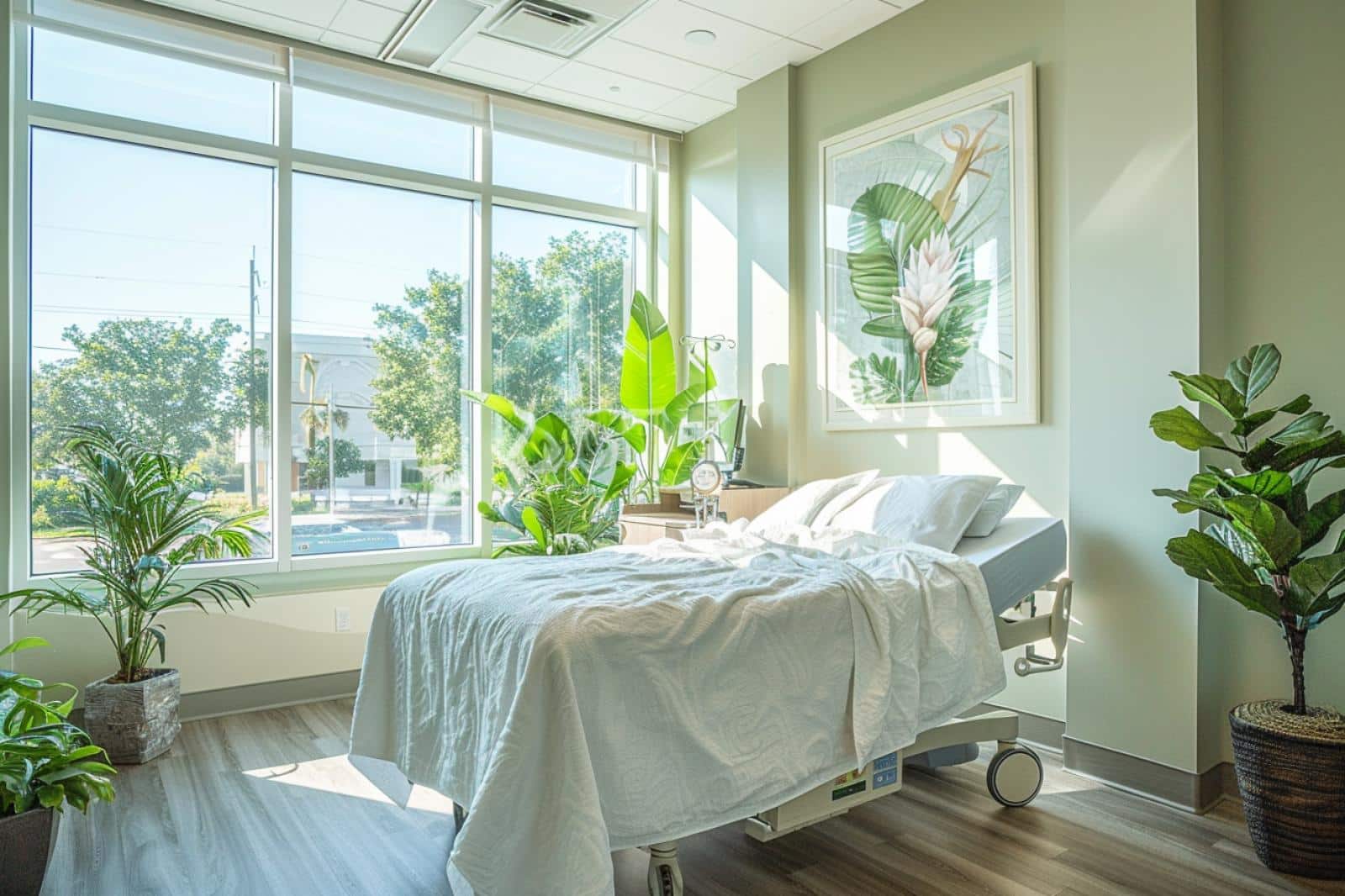The design of healthcare facilities often prioritizes utility and efficiency, relegating aesthetics to a secondary role. However, incorporating aesthetic design into hospital settings can have a profound impact on patient recovery and well-being. This article explores the ways in which a thoughtfully designed environment can foster healing, enhance care quality, and boost overall patient satisfaction.
The Healing Power of Aesthetic Design
First impressions matter, even in healthcare. The moment patients step into a hospital, their senses interact with the environment around them. From the color palette to the natural light streaming into the waiting room, every detail can have a significant impact on how they perceive the care they are about to receive.
Have you seen this : Can The Adoption of Circadian Lighting in Work Environments Improve Employee Alertness and Sleep Quality?
Research indicates that human beings have a natural inclination to seek connections with nature, a concept known as biophilia. Integrating elements of biophilic design such as natural light, greenery, and nature-inspired textures and patterns into hospital facilities can create a more comforting and welcoming environment for patients.
Access to natural light can regulate patients’ circadian rhythms, improving sleep quality and mood. The presence of plants can purify the air and reduce stress, contributing to a healing environment. Also, nature-inspired design elements can provide sensory stimulation, diverting attention from the discomforts of illness and promoting relaxation and well-being.
This might interest you : How Does Integrating Aesthetic Design in Hospital Settings Influence Patient Recovery and Well-being?
Patient-centered Design
In the quest to humanize healthcare, patient-centered design plays a crucial role. This design philosophy aims to create facilities that prioritize patients’ needs, preferences, and values.
Private rooms, for instance, offer patients a sense of control and autonomy, enhancing their comfort and satisfaction. Designing rooms with adequate space for family visits can facilitate social support, which is crucial for emotional well-being and recovery.
Moreover, clear signage and intuitive wayfinding can reduce anxiety and confusion, making the hospital experience less daunting for patients and their families. The integration of technology can also improve patient experience, enabling easy access to information and enhancing communication with healthcare staff.
The design of hospital spaces can also impact staff efficiency and morale. A well-designed workspace can reduce staff fatigue, improve workflow, and facilitate collaboration among healthcare professionals, ultimately enhancing patient care quality.
The Role of Art in Aesthetic Design
Art can transform sterile hospital spaces into environments of healing and inspiration. Incorporating visually appealing elements such as paintings, murals, and sculptures can enhance the aesthetic appeal of healthcare facilities, creating positive distractions that can alleviate anxiety and stress.
Furthermore, art can facilitate emotional expression and communication. In pediatric settings, for instance, colorful and playful designs can make hospital visits less intimidating for children, fostering positive emotions and resilience.
The Impact of Color in Aesthetic Design
Color can influence moods, emotions, and behaviors. Therefore, thoughtful color selection is a crucial aspect of aesthetic design in healthcare settings.
Warm colors like red and orange can stimulate and energize, while cool colors like blue and green can promote relaxation and tranquility. Neutral colors can create a calming and comfortable environment, helping patients to relax and feel at ease.
In addition, color contrast can facilitate navigation for elderly patients and those with visual impairments, enhancing accessibility and safety within the healthcare facility.
Aesthetic Design as a Quality Metric
Healthcare quality is often measured in terms of clinical outcomes. However, as the healthcare industry shifts towards a more holistic, patient-centered approach, the aesthetic quality of the environment is emerging as an important metric.
A well-designed hospital environment can improve patient satisfaction, which is linked to better health outcomes. Patients who are comfortable and at ease are likely to have a more positive perception of the care they receive, which can boost their confidence in the healthcare team and encourage their cooperation and participation in the treatment process.
Moreover, a positive hospital environment can enhance staff satisfaction, productivity, and retention. Happy, motivated staff can provide better care, contributing to improved patient outcomes and overall healthcare quality.
In conclusion, integrating aesthetic design in hospital settings can influence patient recovery and well-being in profound ways. By creating environments that resonate with patients’ needs and preferences, healthcare providers can foster healing, enhance care quality, and boost patient and staff satisfaction.
The Influence of Interior Design on Mental and Behavioral Health
The impact of hospital design extends beyond physical comfort and encompasses aspects of mental and behavioral health. The built environment of healthcare facilities can significantly influence patients’ mood, stress levels, and overall perception of their hospital experience.
The design of patient rooms, for instance, can profoundly influence patients’ mental well-being. Research suggests that patients with access to a view of nature from their rooms tend to recover faster and require less pain medication compared to those without such views. This is an evidence-based design approach that leverages the healing power of nature to improve patient outcomes.
Similarly, the layout and design of shared healthcare spaces, such as waiting rooms and cafeterias, can foster social interaction and community building, reducing feelings of isolation and promoting a sense of belonging. Incorporating homelike elements into these communal spaces can make them more inviting and comfortable, helping patients and their families to cope with the stress of hospitalization.
Moreover, the integration of calming elements such as water features, soothing music, and soft lighting can reduce anxiety and promote relaxation, contributing to an overall healing environment.
Prioritizing Patient Safety in Facility Design
Patient safety is a paramount concern in healthcare, and the physical environment of healthcare facilities plays a crucial role in ensuring it. Design decisions can directly impact patient safety, making it an essential aspect of aesthetic design.
For instance, the design of patient rooms can influence infection control efforts. Ensuring adequate space for cleaning, integrating hand hygiene stations, and using antimicrobial materials can help to reduce the spread of infections.
Similarly, thoughtful layout and design can minimize risks of falls and injuries. Clear pathways, adequate lighting, and accessible bathroom facilities are all vital considerations in creating a safe and patient-friendly environment.
Additionally, the design of healthcare facilities can support staff in providing safe and efficient care. Well-planned workspaces can reduce staff fatigue and errors, improve workflow, and facilitate rapid response in emergencies.
In the context of behavioral health, facility design can promote safety by creating calm, therapeutic environments that minimize stress and agitation. Using soft colors, minimizing noise, and providing opportunities for privacy and personalization can help to create a supportive environment for patients dealing with mental health issues.
Aesthetic Design: A Path to Improved Healthcare
In summary, integrating aesthetic design in hospital settings goes beyond creating visually appealing environments. It is a strategic approach that can significantly influence patient recovery, well-being, and satisfaction.
A well-designed built environment can enhance patient comfort, promote mental and behavioral health, and ensure patient safety. Natural light, biophilic elements, color psychology, art, and patient-centered design all play crucial roles in creating healing environments.
Moreover, a thoughtfully designed healthcare facility can boost staff morale and efficiency, contributing to improved patient care and outcomes. As healthcare continues to evolve and prioritize patient experience and outcomes, the role of aesthetic design in shaping healthcare spaces will undoubtedly continue to grow.
Therefore, aesthetic design should not be an afterthought in the planning and construction of healthcare facilities. Instead, it should be an integral part of the process, with the ultimate goal of enhancing patient recovery and well-being and improving the overall quality of healthcare.
In the realm of healthcare, the significant roles played by physicians, nurses, and medical staff often overshadow an important element that silently yet effectively impacts patient recovery and well-being – the design of hospital environments. Today, we will delve deeper into the importance of aesthetic design in hospital settings and how it influences the recovery and well-being of the patients.
The Impact of Aesthetic Design on Patient Recovery
Aesthetic design in healthcare is not simply about creating pleasing spaces. It’s a delicate balance between aesthetics and functionality, which is key to promoting health and wellness among patients. You might wonder, "How does the design of a room affect patient recovery?" The answer lies in the environment’s impact on a person’s psyche.
The Healing Influence of Nature
A key component of aesthetic design in healthcare is the integration of natural elements. The presence of plants, the use of natural light, and the incorporation of nature-inspired design elements have a profound impact on patient recovery.
Research points to the benefits of exposure to natural light and greenery in expediting healing. Natural light can significantly influence patients’ mood, sleep patterns, and perception of pain. A study revealed that patients exposed to increased natural light experienced less perceived stress and took fewer analgesics, thus improving their overall well-being.
Incorporating plant life into hospital settings also has a notable impact. The simple presence of indoor plants can reduce patients’ stress levels and blood pressure, contributing to faster recovery.
Enhancing Patient Comfort through Design
The layout of rooms, the choice of colors and textures, and the overall ambiance significantly affect a patient’s comfort levels. A well-designed room can help a patient feel more at home, reducing anxiety and facilitating recovery.
Color plays a vital role in this aspect. Warm colors can stimulate, while cooler hues tend to have a calming effect. Soothing colors, like blues and greens, are often used in healthcare facilities to promote a sense of tranquility.
Texture is another design element that can impact patient comfort. Soft furnishings and tactile surfaces can invoke a sense of comfort and safety, subtly promoting patient well-being.
The Role of Design in Enhancing Healthcare Quality
In addition to directly impacting patient recovery, aesthetic design in healthcare settings also plays a significant role in enhancing the overall quality of healthcare. It does so by improving staff efficiency, fostering patient-staff relationships, and facilitating seamless care delivery.
Design Aids in Staff Efficiency
The design and layout of healthcare facilities can significantly impact staff efficiency. A well-planned design facilitates smooth movement and enhances staff collaboration. Clear signage and easy navigation allow staff to respond quickly in emergencies, thereby directly impacting patient care quality.
Moreover, providing comfortable and pleasing spaces for staff, such as break rooms with natural light and greenery, can also contribute to reducing staff stress levels, thereby improving their efficiency and job satisfaction.
Improving Patient-Staff Interactions
The design of patient rooms and communal spaces can influence the quality of interactions between patients and healthcare staff. For example, private rooms allow for more personal, one-on-one interactions, which can improve the patient-staff relationship and promote better healthcare outcomes.
On the other hand, communal spaces designed for social interaction can help reduce feelings of isolation among patients, fostering a sense of community and support.
The Long-Term Impact of Aesthetic Design in Healthcare
While the immediate benefits of aesthetic design in hospital settings are apparent in patient recovery and enhanced healthcare quality, the long-term impact of such design choices is equally significant. They contribute to creating a culture of wellness, fostering patient satisfaction, and improving overall healthcare outcomes.
Fostering a Culture of Wellness
Aesthetic design in healthcare goes beyond physical spaces. It plays a pivotal role in creating an environment that fosters a culture of wellness. Such an environment promotes healthy behaviors, emotional well-being, and patient empowerment.
Design elements like communal spaces for physical activities, quiet areas for relaxation, and interactive areas for patient education can help foster this culture of wellness.
Patient Satisfaction and Overall Healthcare Outcomes
The design of healthcare facilities can significantly influence patient satisfaction. A pleasing and comfortable environment enhances the patient experience, fostering satisfaction. Satisfied patients are more likely to follow care plans, engage with healthcare providers, and maintain long-term relationships with the facility, thus improving overall healthcare outcomes.
Integrating aesthetic design in hospital settings therefore goes beyond creating visually pleasing spaces. It impacts patient recovery, enhances healthcare quality, promotes wellness, fosters patient satisfaction, and ultimately, improves overall healthcare outcomes. It’s high time healthcare facility designers and administrators give design the attention it deserves.
Aesthetic Design and Mental Health
In our discussion about the importance of aesthetic design in healthcare, it’s crucial to underscore its influence on patients’ mental health. Our physical environment plays a vital role in our psychological well-being and this holds even more weight in a healthcare setting where patients might be battling stress, anxiety, fear, or depression.
The incorporation of elements such as natural light, greenery, and calming colors helps create a healing environment conducive to improving patients’ mental health. Natural light, for instance, has been linked to improved mood and reduced depressive symptoms. Therefore, healthcare spaces designed with large windows or skylights to maximize natural light can provide significant mental health benefits.
Similarly, the presence of plants and greenery in patient rooms and communal areas can offer a calming effect, reducing anxiety and promoting relaxation. The use of warm, soothing colors also contributes to creating a comforting and stress-free environment.
Another design aspect that significantly impacts mental health is noise control. Excessive noise can lead to stress and agitation, hindering a patient’s recovery. Therefore, healthcare facilities should incorporate design strategies such as sound-absorbing materials and private patient rooms to mitigate noise and promote tranquility.
Moreover, the integration of elements that promote privacy and personal space can enhance patients’ feelings of control and dignity, thereby positively affecting their mental well-being.
Patient Safety and Aesthetic Design
The integration of aesthetic design in healthcare settings isn’t just about creating visually pleasing spaces. It also has a significant role to play in ensuring patient safety. A well-considered facility design can minimize risks and enhance safety measures, thereby contributing to improving patient outcomes.
For instance, the layout and design of patient rooms can influence patient safety. Rooms designed with adequate space around the bed facilitate easier movement and access for medical staff and caregivers, thereby reducing the risk of patient falls or injuries.
Similarly, clear and intuitive signage can enhance navigation within the healthcare facility and prevent confusion. This is particularly important in emergency situations where quick and accurate access to different areas within the facility can influence patient outcomes.
Moreover, the incorporation of infection control measures in the design of healthcare spaces has become increasingly important in recent years. This can include the use of materials that are easy to clean and disinfect, sufficient ventilation and air filtration systems, and design layouts that minimize cross-contamination.
Therefore, in the realm of healthcare, aesthetic design is not just about creating beautiful spaces, it’s about creating efficient, safe, and healing environments that promote patient recovery and well-being.
Conclusion
In conclusion, the integration of aesthetic design in healthcare facilities is a powerful tool that can significantly influence patient recovery, well-being, and satisfaction. It’s a delicate balance of functionality and aesthetics, creating spaces that are not only pleasing to the eye but also promote healing, ensure patient safety, and enhance healthcare quality.
The careful consideration of design elements – from the integration of natural light and greenery to the choice of colors, textures, and layout – can create a healing environment that fosters a culture of wellness and patient empowerment.
Moreover, a well-designed healthcare facility can improve staff efficiency, enhance patient-staff interactions, and facilitate seamless care delivery. It can also play a significant role in promoting mental health and ensuring patient safety.
In the light of evidence-based research highlighting the profound impact of aesthetic design on patient outcomes and satisfaction, it’s clear that healthcare facility design deserves more attention and investment. It’s high time we recognize the silent yet powerful role of design in the healthcare space, and leverage it to create environments that truly promote healing and wellness.











